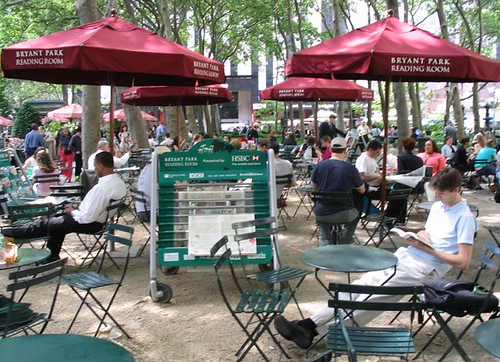Breakthrough parks planning in DC requires visionary leadership

(Image of Bryant Park by Kim Briggs.) To break the logjam of relative mediocrity with parks planning and management in DC, DC needs to hire one of the best parks planners or parks managers in the U.S. to run the parks and recreation department.
I have complained for many years that DC doesn't have a parks master plan--well, it does, it was finished in 2005 but it was neither released publicly nor approved.
There is the Capital Space effort which I have been critical of but I should be more mindful of its importance as a first effort to begin to get the National Park Service and DC (and the National Capital Planning Commission, the federal agency tasked with coordinating federal government planning in the DC region) to do more coordinated planning, management, and operations of the parks and recreational facilities in the city.
DC is in an odd position. Because this is the federal city, under control of the federal government directly until 1973, historically, many of the parks functions were performed by the federal government, specifically the National Park Service.
The National Park Service isn't set up to manage parks that serve local constituencies, especially in a city.
DC's parks and recreation system has the same problem within the general profession, the tension between parks and open spaces as passive places where conservation and preservation are priorities versus providing recreational spaces suitable for active use. (This is an issue in many places, even in Montgomery County, which has separate parks and recreation operations.)
The best parks system plans for both types of facilities and use.
But without a plan, pretty much you can be assured that you get underfunctioning resources.
I have mentioned many times the work of David Barth, a parks planner at AECOM. His writings (and efforts running parks master planning efforts) demonstrate that we could do so much better in DC if we would make excellence in parks and recreation a priority.
Some of the writings of David Barth include:
- (with Carlos Perez) Leadership and the Role of Parks and Recreation in the New Economy.
- Parks System Master Plans: Tools for Sustainable Communities
- City of Tampa Parks Master Plan appendix discussion of Barth's "City Revival" approach, linking new urbanism concepts with the City Beautiful movement
Or how about someone from New York City. What that city has done with public-private partnerships and the revitalization of major parks such as Central Park and Prospect Park and especially Bryant Park is incredible.
Every time I see presentations about great urban parks, I continually ask myself why it is so impossible to achieve similar kinds of excellence in DC?

Bryant Park Reading Room.
Granted, New York has many advantages. For one, because for many people where they live is small, they recreate-relax-pass time in public spaces like local parks, coffee shops, restaurant patios, etc. And the city has a lot of private wealth which can be tapped for public-private partnership arrangements. And there is a lot of density of population and businesses and nonprofit organizations, which allows for a goodly amount of human, social, and organizational capital that can be tapped and brought to bear on these kinds of improvement projects.
One of the points made in yesterday's ASLA session is that an advantage that nonprofit organizations running public-private partnerships can have over city agencies is continuity of leadership and management and the maintenance of expertise and knowledge, because with government, the executive and legislative branches may wax and wane with their interest and commitment to any one particular "city" function, and that in normal circumstances, parks are seen as a lower priority.
This is definitely the case in DC. First, there hasn't been a commitment to professional leadership--professional defined as someone who is a parks-planning professional. Second, there hasn't been consistent leadership, with many many directors over the past 10 years.
Labels: civic engagement, land use planning, parks and open space, provision of public services



1 Comments:
Thank you from management goes a long way
Post a Comment
<< Home